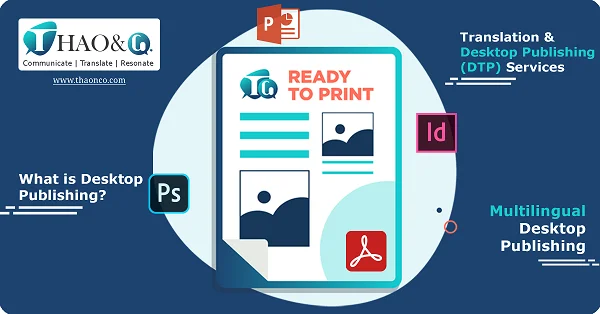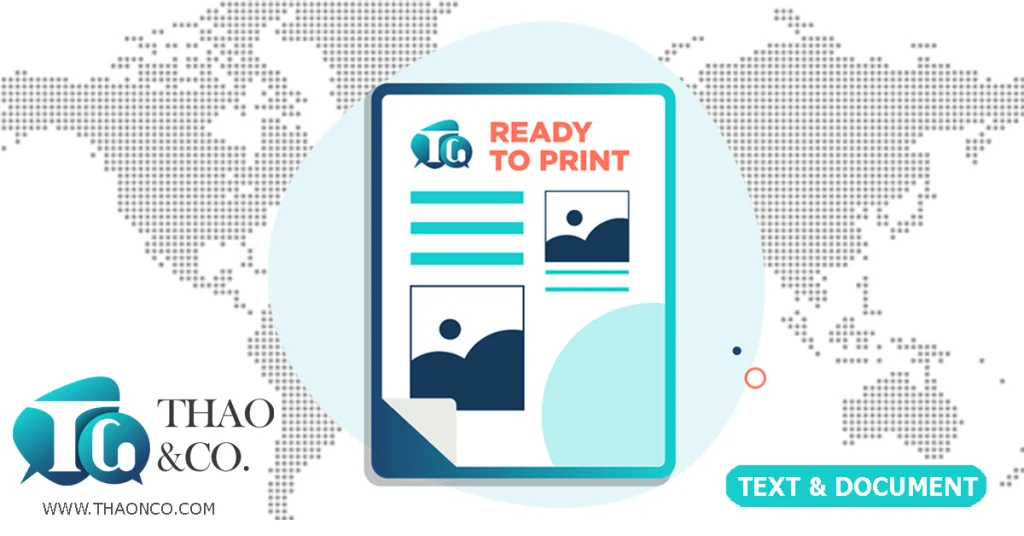Desktop Publishing (DTP) is an essential process in professional translation. It ensures that the aesthetics, logic, and structure of the original file are preserved after translation. DTP is particularly important for documents with complex content and visuals. As DTP plays such a crucial role in translation, what do you know about DTP services and what should you pay attention to when using it?
Desktop Publishing or DTP is a specialized process in translation. DTP requires skills in adjusting layouts and formatting, utilizing specialized design software to create standardized translations while maintaining the original layout.
Due to the need for accuracy and consistency with the original, DTP plays a significant role in the translation of the following types of documents:
Some common examples of technical documents include technology-related texts, product manufacturing processes, and technical support instructions. These documents generally involve units of measurement, diagrams, special formulas, or production flow charts. Therefore, content formatting after translation is necessary to ensure an accurate layout.
Similar to technical documents, medical and healthcare is a specialized category in translation. Translations of medical documents such as patient records, clinical guidelines, scientific research, or large medical journals require accuracy in medical terminology as well as a comprehensive layout of medical images, charts, medical records, and others.
This category includes research papers, scientific articles, theses, dissertations, textbooks, and teaching materials. The translation of these documents needs to match the original in terms of format as well as charts, tables, and inter-page layouts.
Translating and localizing promotional materials such as posters, brochures, catalogs, banners, standees, and others needs Desktop Publishing. This makes the translated versions of these materials more appealing and enhances the effectiveness of marketing communications regarding the advertising message.

Maintaining aesthetics after translation is of utmost importance, especially for documents with complex layouts combining text and images. Therefore, the following elements are crucial in the Desktop Publishing process:
1. Text size and format: Before starting Desktop Publishing, DTP specialists have to identify the original document’s format structure to ensure an accurate layout arrangement that closely resembles the source document.
Besides, the translation should be presented in a way that is clear and easy to read. Bullets, numbering, headings, footers, and paragraphs should be logically and appropriately organized.
Some unique languages, like Arabic, are read and written from right to left. In such cases, the text will be right-aligned, and DTP specialists will make appropriate adjustments.
2. Margins and spacing between characters and punctuation: The alignment and spacing of in-text elements such as paragraphs, characters, punctuation, images, and charts, need to be uniform and balanced across pages.
3. Fonts: Ensure that the fonts are easy to read and align with the target language, and avoid inconsistency in fonts between paragraphs.
In some cases, the fonts of the source language may not support the target language’s characters. For instance, Vietnamese fonts may not support Korean ideographic characters. DTP specialists need to find suitable alternative fonts with similar visual characteristics.
4. Images and charts: For documents containing images and charts, these elements need to be translated and inserted with an accurate resolution and size compared to the source document. How these elements are presented on screens and in print should also be considered.
5. Colors: If the document is in color, it is essential to maintain consistency not only in text and fonts but also in the color balance of visual elements. In the last step, the final DTP work is compared with the actual print version.
Additionally, Desktop Publishing requires other factors such as compatibility with DTP printing techniques, proofreading before printing, storing, and ensuring document confidentiality. Placing a focus on these elements can help to produce accurately formatted and appealing Desktop Publishing documents.

Besides maintaining the accuracy of the translation, the visual presentation remains one of the key factors in determining the quality of the final document. Here are the reasons why the Desktop Publishing process should not be overlooked in translation:
Desktop Publishing ensures that the translated content is placed properly in the right context. Additionally, the arrangement of content and images should be appropriate to appeal to the target audience’s preferences. Translation agencies that offer DTP services can guarantee that the translated documents are precise and attractive in both content and form.
Each language possesses unique characteristics and properties. Differences in word structures, grammar, and syntax can directly impact the quality of the translation. For instance, when translating from English to Vietnamese, the word count can increase up to 15-30%, depending on the type of text, and vice versa.
Similarly, languages such as Chinese, Korean, and Japanese require special fonts and sentence structures. Some languages are written from right to left, contrary to the majority of languages in the world. In addition to ensuring accurate content, translation agencies should also consider the layout and design of the translated document to suit the reading and writing standards of each specific language.
Desktop Publishing helps maintain consistency in layout and design between the original and translated documents. DTP specialists need to flexibly adjust formatting and use fonts aligned with the source document to ensure consistency and avoid unnecessary errors such as font issues during printing.
You can preview and directly edit the content of the document via professional DTP software or other file formats. It is essential to consider the arrangement of text and images, maintain the layout of the document to minimize printing errors and ensure that the translated document is correctly presented on paper.

Desktop publishing covers numerous elements, including layout, design, and arrangement of content and images. Translation agencies unfamiliar with DTP may not be able to guarantee the quality of the final translated document. Therefore, you should wisely choose a translation service that provides professional Desktop Publishing services with extensive experience.
One of the professional translation agencies you can consider is Thaonco.com – a leading agency providing translation services for clients in various industries. Working with Thao & Co., clients can be assured about the quality and commitment.
Text and document translation service at Thao & Co. is the finest choice for many global companies and businesses. Our team of native linguists experienced in working with top global brands is committed to providing the highest quality and professionally standardized translations that connect you with customers globally.

Upon request, Thao & Co. will work with either our skilled in-house or international DTP specialists to format the design and layout for consistency with your source files. Before delivery, our expert linguists will proofread the translation a final time to ensure that the finished document is ready for printing and flawless in every detail.
Other than common document formats like Microsoft Word, Powerpoint, or PDF, Thao & Co. also offers translation and Desktop Publishing services in other formats, including Adobe FrameMaker, InDesign, InCopy, HTML, and more.
Desktop Publishing is an important process that may directly affect the final work. Choosing a professional translation and Desktop Publishing service can help you mitigate potential problems and ensure the success of your project.
Please leave your information on our Get a Quote page for prompt assistance!